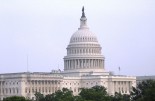Fidelity: US Treasury and global government bond comment

We’ve had over 10 years of global investors increasingly allocating to the US, where the US dollar has gone from the weakest level in recent history in 2013, to the most expensive on a trade weighted basis since 1986 by January this year.
The ‘US exceptionalism’ narrative was all consuming - everyone’s portfolios were tilted towards the US, partly because that’s where economic growth has been greatest, and where the biggest returns have been.
Since the end of January this year, we’ve seen evidence of a cyclical downturn in the US, which initially saw US Treasuries rally and the dollar weaken, as would be expected when the market prices in additional rates cuts. But long dated US Treasury yields have sharply risen since the beginning of March, which is concerning when risk assets are coming under pressure. And long dated US real yields have only ever been meaningfully higher now than in the US regional banking crisis in March 2023 and in October 2008. Before then, you have to go back to the 1990s.
Firstly, it’s easiest to say what is NOT causing US Treasuries to sell off. This is not due to inflation expectations - while markets had been pricing in a jump in US CPI to 4% this year on tariff announcements, the 90-day delay, combined with a slump in oil, has meant that near term inflation expectations have fallen back towards 3%. And market implied medium to long term inflation expectations have slumped to the lowest levels since mid-2020. Clearly higher nominal and real yields aren’t due to booming growth expectations either, given the lurch lower in risky asset prices.
Nor does this appear to be driven by the unwind of the ‘basis trade’. As has been well documented, hedge funds are estimated to have trades to the tune of as much as $1tn as they try to arbitrage the slightly higher interest rates achievable on US Treasuries versus what is implied by the underlying US Treasury futures. But the key point is that these investors are not net long US Treasuries.
If they sell their positions in US Treasuries, they buy back Treasury futures. It doesn’t mean that the unwind of these basis trades can’t cause dysfunction - if they all sell US Treasuries en masse then there will likely be dislocations between individual bonds on the US Treasury curve, and liquidity would be greatly impaired across individual US Treasuries. But this doesn’t seem to be happening - if it was, then we’d be seeing some crazy moves in repo rates (which fund these trades), but we’re not.
US relies on ‘kindness of strangers’
The problem that the US economy faces is that it is a twin deficit economy, with sustained fiscal and current account deficits. Like any twin deficit economy, the US is reliant on the ‘kindness of strangers’ to fund it. US policy has not been kind to strangers lately. The sharp move higher in longer dated government bond yields, coupled with a weaker US dollar, looks like good old capital flight. The global ‘bond vigilantes’ are clearly alive and well.
It is difficult to see exactly who is selling down US Treasuries. There’s a lot of speculation that China may be involved, but there’s no hard evidence. Some point the finger at Japan, but if domestic Japanese investors were switching into Japanese government bonds, then JGBs would be enjoying a huge rally. And yet long dated JGB yields are also at the highs.
The substantial rally in the euro, coupled with the move lower in German government bond yields, is indicative that some of this move could be European based investors bringing money back home, with some having fled bunds on the announcements of German borrowing plans earlier this year.
To a lesser extent, it’s likely that some emerging markets have also been contributing to US Treasury weakness. EM currencies have been under moderate pressure, which has prompted some to sell down their reserves to prevent a disorderly depreciation. They do this by liquidating their dollar reserves, which mostly involves selling Treasuries.
Longer term, something to consider regarding US trade policy is the role that the US consumer has indirectly played for many years in keeping US Treasury yields lower. Part of the story of the persistent ‘global imbalances’ and US trade deficits is that the American consumer has been buying overseas goods and sending dollars overseas. These dollars then get recycled back into the US economy, including overseas buying of US Treasuries.
If US trade policy succeeds in reducing or even eliminating trade deficits, then there will be less overseas funding of US government bond issuance. This means the US will have great difficulty maintaining its policy of deficit fuelled growth, without causing continued ruptures in the US Treasury market.








